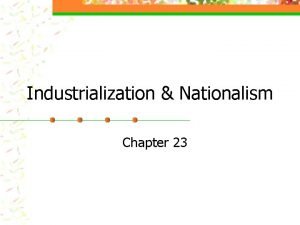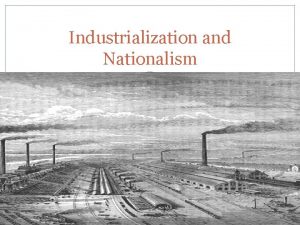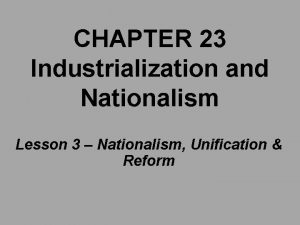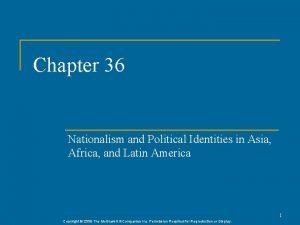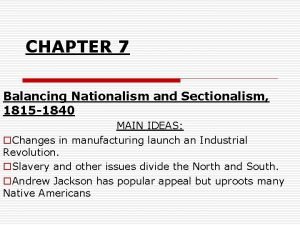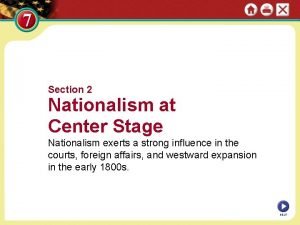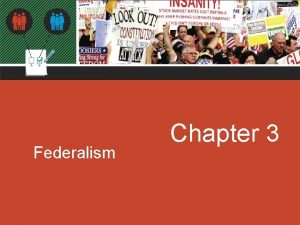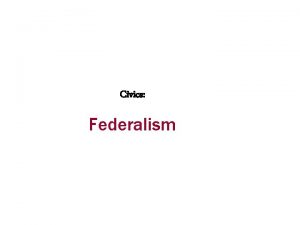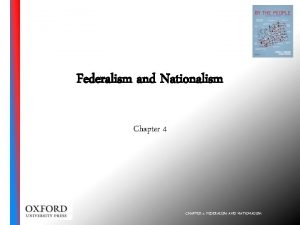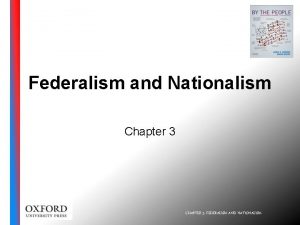Federalism and Nationalism Chapter 3 CHAPTER 3 FEDERALISM









- Slides: 9

Federalism and Nationalism Chapter 3 CHAPTER 3: FEDERALISM AND NATIONALISM

In this chapter, you will: • Learn what federalism is • Explore the strengths of federal and state governments • Examine how federalism works—how it has evolved • Review the contemporary conflicts that surround federalism • Explore American nationalism, the force that binds and shapes our federalist polity CHAPTER 3: FEDERALISM AND NATIONALISM

Forging Federalism • The United States rebelled against a unitary system and rejected a federation after trying one for a decade. • The Constitutional Convention created a new hybrid form of government: a federal system of shared and overlapping powers. Power is divided and shared between national and state governments. • American federalism is further complicated by local governments, which are reliant on state government for their authority. CHAPTER 3: FEDERALISM AND NATIONALISM

Who Holds Government Authority? • The most important question in federalism is where to place responsibility—on the state or national level. • State-level policy has four advantages: It reflects local needs, enables innovations in the laboratories of democracy, protects rights, and enhances choice. • National-level policy also has four advantages: It enhances fairness (avoiding a race to the bottom), equalizes resources, promotes national standards and best practices, and facilitates coordination. CHAPTER 3: FEDERALISM AND NATIONALISM

How Federalism Works • The Constitution grants the national government both delegated (or enumerated) powers and implied powers. Some features of the Constitution emphasize broad national powers (e. g. , the elastic clause); others seem to emphasize state power (the Tenth Amendment). • Successive eras of federalism: dual federalism with clearly demarcated authority; cooperative federalism with federal dominance and blurred lines; New federalism, less federal money, more state authority – now a goal of the Trump administration; and Progressive federalism with national goals and state innovations. • Federalism reflects the increasing polarization of the country. CHAPTER 3: FEDERALISM AND NATIONALISM

Issues in Federalism • Devolution transfers responsibility back to state and local governments. • Both parties in office take a varied approach that belies the simple expectation that Democrats seek national programs while Republicans try to devolve power to state and local authorities. • The courts have played an important role in defining federalism • In recent years the Supreme Court has tended to tilt toward local and state power. CHAPTER 3: FEDERALISM AND NATIONALISM

Nationalism, American Style • Americans have long felt a strong sense of nationalism. This helps bind together a large and diverse nation with a fragmented government. • Nationalist bonds can also turn corrosive and exclusionary. “Nationalists” claiming America stands only for Anglo-Saxons or Christians or English speakers sow division. • A weak government means that American institutions (and officials) rank relatively low on three dimensions: size, authority, and independence. • The political results include an emphasis on citizen participation, the importance of building alliances, and a reliance on power and money. CHAPTER 3: FEDERALISM AND NATIONALISM

Nationalism, American Style – America’s Weak National Government • Passionate nationalist sense linked to relatively weak governing institution • Strength of central governments measured by three principles: size, authority and independence • Size – American national government smaller than other nations – Grew after World War I – U. S. government still spends less than most other wealthy nations CHAPTER 3: FEDERALISM AND NATIONALISM

Nationalism, American Style • Authority – Most developed nations had powerful and efficient national bureaucracies, American government engaged citizens without bureaucracy – Civic voluntarism: citizens voluntarily participating in public life without government involvement » » Projected robust nationalist feeling Widespread individual efforts for the common good Lived on for generations U. S. emphasizes community participation over centralized administration – Independence » Americans separate and divide governing power more than any other wealthy country » Federalism operates along a vertical dimension » Power is shared among different levels of government CHAPTER 3: FEDERALISM AND NATIONALISM
 Revolution
Revolution Lesson quiz 10-1 industrialization and nationalism
Lesson quiz 10-1 industrialization and nationalism Chapter 10 industrialization and nationalism
Chapter 10 industrialization and nationalism Chapter 35 nationalism and political identities in asia
Chapter 35 nationalism and political identities in asia Chapter 23 lesson 3 nationalism unification and reform
Chapter 23 lesson 3 nationalism unification and reform Chapter 36 nationalism and political identities in asia
Chapter 36 nationalism and political identities in asia Chapter 30 revolution and nationalism worksheet answers
Chapter 30 revolution and nationalism worksheet answers Chapter 7 balancing nationalism and sectionalism
Chapter 7 balancing nationalism and sectionalism Chapter 29: nationalism around the world answers
Chapter 29: nationalism around the world answers Nationalism at center stage
Nationalism at center stage
